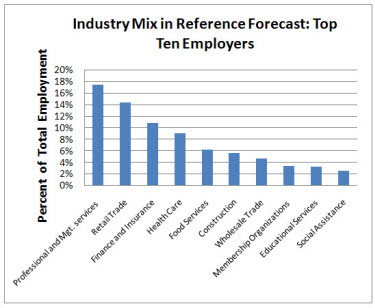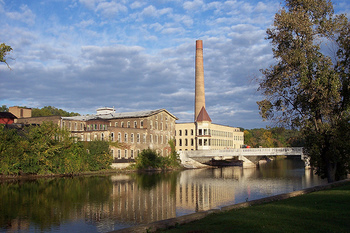Industry Mix Scenario Outcome
by Flickr user Springsun
GO TO 2040 scenarios are expected to impact the relative concentration of industry sectors in the region. Industry sectors are broad categories of business types, such as manufacturing, construction, or retail trade. "Industry mix" refers to the region's relative concentration of businesses within the sectors, and the changes expected to occur across various industry sectors as a result of different investment strategies.

In each scenario, public sector investments are focused differently and impacts will likely depend on how each sector develops in our region. GO TO 2040 includes a forecast of the types of jobs expected across various industry sectors, based upon trends over the last forty years. The chart on the left shows the top ten industries in terms of employees, based on the reference forecast. A brief report with similar information is available here.
Based on the GO TO 2040 reference forecast, we expect continued growth in the sectors of professional and management services, educational services, health care, and finance and insurance. Similarly, we expect a continued decline in some sectors of the region's manufacturing industry. Based on current trends, retail and wholesale trade, construction, and the Transportation and warehousing sector are expected to remain relatively stable without much growth or decline relative to other industries.
Change in industry mix compared to current trend |
|
|
Reinvest |
Construction, retail and wholesale trade, various services, Transportation and logistics, and some manufacturing sectors are expected to increase. |
|
Preserve |
Professional and management services, finance and insurance, health care, education and social services, and the arts, entertainment, and recreation sectors are expected to increase. |
|
Innovate |
Various manufacturing sectors (specifically those related to green technology) including fabricated metals and computers and electrical products. Also, scientific and technical research and development and services are expected to increase. |
What strategies in this scenario caused this change? |
|
|
Reinvest |
Substantial systematic improvements in infrastructure investment, including capital improvements to transit facilities, freight operations improvements, arterial improvements, and expansion and modernization of water and wastewater systems will provide the modernized infrastructure necessary to facilitate expansion of existing businesses, creation of new ones, and the relocation of other businesses to join the established, thriving sectors already here. These forecast impacts should increase the number of jobs for a workforce that already has extensive experience in these industries. The construction and trade sectors and supporting industries such as warehousing and logistics are forecast to grow in this scenario. |
|
Preserve |
Major investments in education and workforce development as well as in open space and arts and culture institutions will build on the region's high quality of life and make it more attractive to a skilled workforce, thus making it more attractive for businesses to expand or relocate to the region. In turn, this will help retain existing companies and lure new ones to the Chicago area to capitalize on the non-wage benefits to workers from living in the region. Jobs in the tourism and service sectors that capitalize on the region's high quality of life are also likely to increase. |
|
Innovate |
Major investments in green technology development, green manufacturing, clean energy sources and intelligent transportation systems will encourage the diversification of existing industry into new areas and will facilitate the creation of entirely new industrial sectors. This process will help train and diversify the existing labor force, and will draw upon newly trained workers from the region's education, scientific, and technical services sectors, which will in turn increase demand in these sectors. |
The results shown above are based on economic and industry reference forecasts provided by the Regional Economic Applications Laboratory (REAL) as well as other recent research on infrastructure, innovation, and green jobs provided for CMAP by RCF Economic and Financial Consulting. These reports currently exist in draft form only. Full detailed analyses will appear in this space when available.
